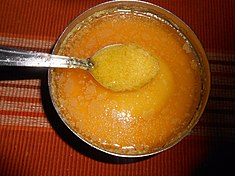
Back سمن حيواني Arabic سمنه بلدى ARZ Qhi Azerbaijani ঘি Bengali/Bangla Ghí Czech Gî Welsh Ghee Danish Ghee German ދަހީ DV Gio Esperanto
 | |
| Nutritional value per 100 g (3.5 oz) | |
|---|---|
| Energy | 3,660 kJ (870 kcal) |
0 g | |
99.5 g | |
| Saturated | 61.9 g |
| Monounsaturated | 28.7 g |
| Polyunsaturated | 3.69 g |
0.3 g | |
| Minerals | Quantity %DV† |
| Calcium | 0% 4 mg |
| Iron | 0% 0 mg |
| Phosphorus | 0% 3 mg |
| Potassium | 0% 5 mg |
| Sodium | 0% 2 mg |
| Other constituents | Quantity |
| Water | 0.24 g |
| Cholesterol | 256 mg |
| †Percentages estimated using US recommendations for adults,[1] except for potassium, which is estimated based on expert recommendation from the National Academies.[2] | |
Ghee is a type of clarified butter, originating from India.[3] It is commonly used for cooking, as a traditional medicine, and for Hindu religious rituals.[4]
- ^ United States Food and Drug Administration (2024). "Daily Value on the Nutrition and Supplement Facts Labels". Retrieved 28 March 2024.
- ^ National Academies of Sciences, Engineering, and Medicine; Health and Medicine Division; Food and Nutrition Board; Committee to Review the Dietary Reference Intakes for Sodium and Potassium (2019). Oria, Maria; Harrison, Meghan; Stallings, Virginia A. (eds.). Dietary Reference Intakes for Sodium and Potassium. The National Academies Collection: Reports funded by National Institutes of Health. Washington, DC: National Academies Press (US). ISBN 978-0-309-48834-1. PMID 30844154.
- ^ "Perspective | Ghee has been an Indian staple for millennia. Now the rest of the world is catching on". Washington Post. 28 October 2021. ISSN 0190-8286. Retrieved 22 March 2024.
Ghee originated in India, where the heat was not conducive to storing butter for long periods
- ^ "Perspective | Ghee has been an Indian staple for millennia. Now the rest of the world is catching on". Washington Post. 28 October 2021. ISSN 0190-8286. Retrieved 22 March 2024.
ghee is poured into sacred fires by Hindus to this day, a practice thought to be auspicious for marriages, funerals and other ceremonies.